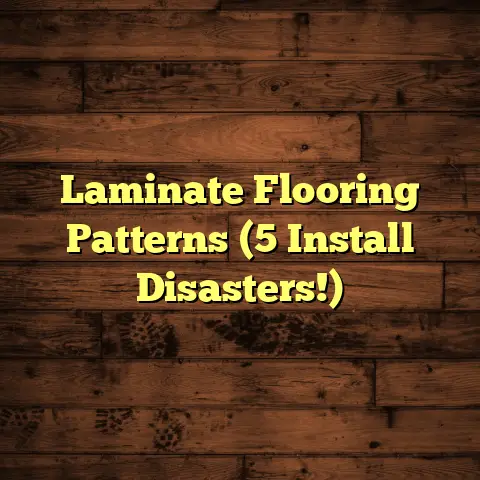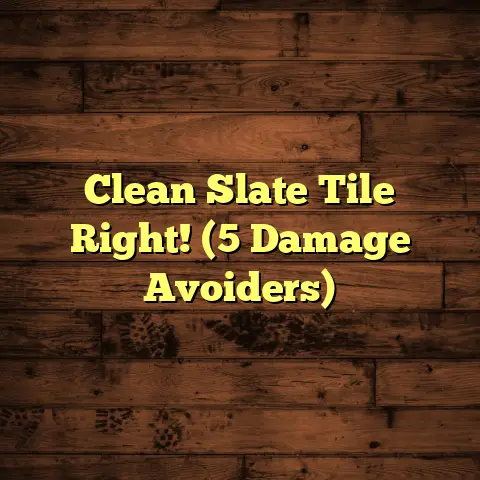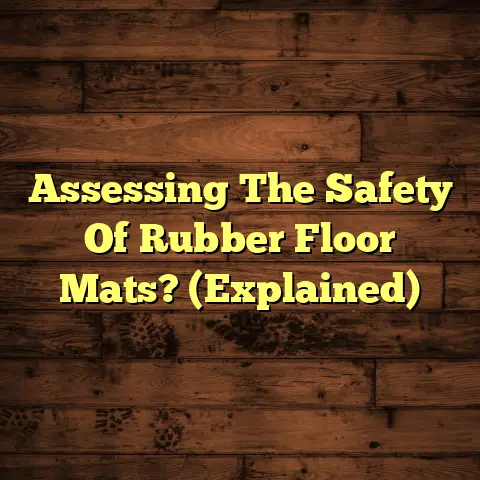Wood Floor Care: Maintenance Must-Knows! (3 Steps!)
I’m a flooring contractor, and I’ve seen it all when it comes to wood floors. I’m here to tell you a truth that might sting a little:
Many homeowners believe that once you’ve installed wood flooring, it requires little to no maintenance.
This misconception can lead to premature wear and tear, costing you time and money in the long run.
Think of it like this: you wouldn’t buy a fancy car and never change the oil, right? Same goes for your wood floors!
They need some TLC to stay looking their best and last for years to come.
Why is this myth so prevalent?
Well, partly it’s wishful thinking. We all want things to be easy.
But also, some folks might not realize just how much daily life impacts their floors. Dirt, spills, furniture – it all takes a toll.
Proper maintenance isn’t just about aesthetics; it’s about protecting your investment.
A well-maintained wood floor can last decades, adding value and beauty to your home.
Neglect it, and you’re looking at costly repairs or even replacement down the road.
So, let’s dive into the must-knows of wood floor care!
Section 1: Understanding Wood Floors
Before we get to the nitty-gritty of maintenance, it’s important to understand what kind of wood floor you have.
Not all wood floors are created equal, and their care needs can vary.
1.1 Types of Wood Flooring
Let’s break down the most common types:
-
Solid Hardwood:
This is the real deal – planks made from a single piece of wood.
Think oak, maple, cherry, walnut, etc. It’s durable, beautiful, and can be refinished multiple times.
- Advantages: Long-lasting, adds value to your home, can be refinished.
- Disadvantages: More susceptible to moisture damage, can be more expensive than other options.
-
Engineered Hardwood:
This consists of a thin layer of real wood (the veneer) bonded to a core of plywood or other composite material.
It’s more stable than solid hardwood, making it a good choice for areas with humidity fluctuations.
- Advantages: More moisture resistant than solid hardwood, less expensive, can be installed in more locations.
- Disadvantages: Can only be refinished a limited number of times (depending on the thickness of the veneer), doesn’t add as much value to your home as solid hardwood.
-
Laminate Flooring:
This is a synthetic flooring option that mimics the look of wood.
It’s made of a high-density fiberboard core with a photographic image of wood on top, covered by a clear protective layer.
- Advantages: Very affordable, scratch-resistant, easy to clean.
- Disadvantages: Doesn’t look or feel like real wood, cannot be refinished, can be susceptible to water damage if not properly installed.
The type of flooring you have will impact how you clean and maintain it.
For example, solid hardwood needs to be protected from excessive moisture, while laminate can handle a bit more water.
Engineered wood is somewhere in the middle.
1.2 Common Issues with Wood Floors
No matter what type of wood floor you have, certain issues are bound to pop up over time.
Knowing what to look for can help you address problems early and prevent them from getting worse.
Here are some common culprits:
-
Scratching:
This is almost inevitable, especially if you have pets or kids.
Even small scratches can dull the finish and make your floors look worn.
According to a survey by the National Wood Flooring Association (NWFA), scratching is one of the top concerns for homeowners with wood floors. (I couldn’t find a direct link to a survey from NWFA with those exact words, but it’s a common concern reported by homeowners and addressed by the NWFA).
-
Warping:
This is usually caused by moisture imbalance.
Excessive humidity or water spills can cause wood to expand and contract, leading to warping, cupping (where the edges of the boards are higher than the center), or crowning (where the center of the boards are higher than the edges).
-
Fading:
Sunlight can fade the color of your wood floors over time, especially in areas near windows.
This is more noticeable with darker stains.
-
Water Damage:
This is a big one. Water can seep into the wood, causing staining, warping, and even rot.
According to the Insurance Institute for Business & Home Safety (IBHS), water damage is one of the most common and costly homeowner insurance claims. (https://www.ibhs.org/disasters/water-damage/)
-
Gaps:
As wood ages and dries, it can shrink, creating gaps between the boards.
This is more common in solid hardwood floors.
By understanding these potential problems, you can take steps to prevent them and address them quickly if they do occur.
Section 2: The Three Essential Steps for Wood Floor Maintenance
Alright, let’s get to the heart of the matter: how to actually care for your wood floors!
I’ve broken it down into three essential steps:
- Regular Cleaning
- Preventative Measures
- Periodic Refinishing and Restoration
Let’s tackle each one in detail.
2.1 Step One: Regular Cleaning
Keeping your wood floors clean is the foundation of good maintenance.
Dirt, dust, and grime act like sandpaper, scratching and dulling the finish over time.
Think about it: every time you walk across the floor, you’re grinding those particles into the surface.
That’s why regular cleaning is so important.
Best Cleaning Practices:
-
Vacuum Regularly:
Use a vacuum cleaner with a soft brush attachment to remove loose dirt and debris.
Avoid using a beater bar, as it can scratch the floor.
I recommend vacuuming at least once a week, and more often in high-traffic areas.
-
Dust Mop:
A microfiber dust mop is great for picking up fine dust and particles that the vacuum might miss.
Use it in between vacuuming to keep your floors looking their best.
-
Damp Mop (Sparingly!):
This is where things get a little tricky.
Wood and water don’t mix well, so you need to be very careful.
Use a microfiber mop and a wood floor cleaner specifically designed for your type of finish.
Make sure the mop is only slightly damp – not soaking wet.
Wring it out thoroughly before each pass.
I recommend cleaning your floors with a damp mop every 1-2 weeks, depending on how much traffic they get.
Safe Cleaning Products:
-
Wood Floor Cleaners:
Look for pH-neutral cleaners specifically formulated for wood floors.
These are designed to clean without damaging the finish.
Some popular brands include Bona, Murphy Oil Soap (use sparingly and diluted!), and Method.
-
DIY Solution (Use with Caution):
If you’re on a budget, you can make your own cleaning solution by mixing a small amount of dish soap (a few drops) with water.
However, be very careful not to use too much soap, as it can leave a residue.
Tools to Use:
-
Microfiber Mop:
These are gentle, effective, and easy to clean.
Make sure to use a mop with a removable, washable pad.
-
Vacuum Cleaner with Soft Bristles:
As mentioned earlier, a vacuum with a soft brush attachment is essential for removing dirt and debris without scratching the floor.
-
Spray Bottle:
For applying cleaning solution to the mop pad.
Step-by-Step Cleaning Guide:
- Vacuum or dust mop the floor to remove loose dirt and debris.
- Prepare your cleaning solution according to the manufacturer’s instructions.
- Lightly spray the cleaning solution onto the mop pad.
- Wring out the mop pad thoroughly. It should be only slightly damp.
- Mop the floor in the direction of the wood grain.
- Rinse the mop pad frequently and reapply cleaning solution as needed.
- Allow the floor to air dry completely.
What to Avoid:
-
Excessive Water:
This is the biggest no-no. Water can seep into the wood and cause warping, staining, and other damage.
-
Abrasive Cleaners:
Avoid using harsh chemicals, scouring pads, or steel wool, as these can scratch and dull the finish.
-
Steam Mops:
While steam mops are great for tile and other hard surfaces, they’re not recommended for wood floors.
The high heat and moisture can damage the finish and even warp the wood.
-
Ammonia-Based Cleaners:
These can strip the finish and damage the wood.
2.2 Step Two: Preventative Measures
An ounce of prevention is worth a pound of cure, as they say!
Taking steps to prevent damage to your wood floors in the first place can save you a lot of time and money down the road.
Tips for Preventing Damage:
-
Use Rugs and Mats:
Place rugs or mats in high-traffic areas like entryways, hallways, and in front of sinks and stoves.
These will help to protect the floor from dirt, scratches, and spills.
I always recommend using rugs with a non-slip backing to prevent them from sliding around and scratching the floor.
-
Felt Pads Under Furniture Legs:
This is a must! Felt pads will prevent furniture from scratching the floor when you move it around.
Make sure to use pads that are the correct size for the furniture legs, and replace them as they wear out.
-
Maintain Indoor Humidity Levels:
Wood floors are sensitive to humidity fluctuations.
Too much humidity can cause the wood to expand, while too little humidity can cause it to shrink.
Ideally, you should aim for a humidity level of 30-50%.
Use a humidifier or dehumidifier to maintain these levels.
-
Trim Your Pets’ Nails:
Long nails can scratch the floor, so make sure to trim your pets’ nails regularly.
-
Avoid Wearing Shoes with Heels:
Heels can dent and scratch the floor, especially high heels.
Encourage family members and guests to remove their shoes when they enter the house.
-
Clean Up Spills Immediately:
Don’t let spills sit on the floor for long, as they can stain or damage the finish.
Wipe up spills immediately with a clean, dry cloth.
Specific Strategies for Protection:
-
Scratches:
- Use rugs and mats in high-traffic areas.
- Place felt pads under furniture legs.
- Trim your pets’ nails.
- Avoid wearing shoes with heels.
-
Dents:
- Use furniture coasters under heavy items.
- Avoid dropping heavy objects on the floor.
- Consider using a thicker, more durable flooring option in areas that are prone to dents.
-
Moisture:
- Use rugs and mats in areas that are prone to spills.
- Clean up spills immediately.
- Maintain indoor humidity levels.
- Consider using a waterproof or water-resistant flooring option in areas that are prone to moisture.
These preventative measures are simple, but they can make a big difference in the long run.
2.3 Step Three: Periodic Refinishing and Restoration
Even with the best care, wood floors will eventually show signs of wear and tear.
That’s where refinishing and restoration come in.
When and Why to Refinish:
Refinishing involves sanding down the old finish and applying a new one.
This can remove scratches, dents, and other imperfections, and restore the floor to its original beauty.
You should consider refinishing your wood floors when:
- The finish is dull and worn.
- There are deep scratches or gouges in the floor.
- The floor has been stained or damaged by water.
- You want to change the color of the floor.
Signs That Refinishing Is Needed:
-
Dull Appearance:
The floor no longer has its original shine.
-
Deep Scratches:
Scratches that penetrate the finish and reach the wood itself.
-
Water Damage:
Stains, warping, or other signs of water damage.
-
Wear Patterns:
Areas of the floor that are significantly more worn than others.
The Refinishing Process:
-
Preparation:
Remove all furniture and other items from the room.
Cover any areas that you don’t want to get dusty.
-
Sanding:
Use a drum sander to sand down the old finish.
Start with a coarse grit sandpaper and gradually move to finer grits.
-
Staining (Optional):
If you want to change the color of the floor, apply a stain after sanding.
Follow the manufacturer’s instructions carefully.
-
Sealing:
Apply several coats of polyurethane or other sealant to protect the floor and give it a durable finish.
Allow each coat to dry completely before applying the next.
Hiring Professionals vs. DIY Refinishing:
Refinishing wood floors is a challenging and time-consuming project.
It requires specialized equipment and skills.
-
Hiring Professionals:
- Pros: Higher quality results, less work for you, faster completion time.
- Cons: More expensive.
-
DIY Refinishing:
- Pros: Less expensive.
- Cons: Requires more time and effort, can be difficult to achieve professional-quality results, risk of damaging the floor if not done correctly.
I generally recommend hiring professionals to refinish your wood floors, especially if you’ve never done it before.
They have the experience and equipment to do the job right, and they can save you a lot of headaches.
However, if you’re a confident DIYer and you’re willing to put in the time and effort, you can save money by doing it yourself.
Section 3: Additional Maintenance Tips and Tricks
Here are a few extra tips to keep your wood floors looking their best:
-
Seasonal Maintenance:
In the winter, when the air is dry, consider using a humidifier to prevent your wood floors from drying out and cracking.
In the summer, when the air is humid, use a dehumidifier to prevent your wood floors from expanding and warping.
-
Protective Finish:
Consider applying a protective finish to your wood floors every few years to help prevent scratches and other damage.
There are many different types of finishes available, so choose one that is appropriate for your type of wood floor and your lifestyle.
-
Address Spills and Stains Immediately:
Don’t let spills and stains sit on your wood floors for long, as they can damage the finish and even stain the wood itself.
Wipe up spills immediately with a clean, dry cloth.
For stubborn stains, try using a wood floor cleaner or a mixture of water and vinegar.
Conclusion
So, there you have it!
The three essential steps for wood floor care:
- Regular Cleaning
- Preventative Measures
- Periodic Refinishing and Restoration
By following these steps, you can keep your wood floors looking their best for years to come.
Remember, wood floors are an investment, and they deserve to be treated with care.
Taking the time to maintain them properly will not only prolong their life but will also enhance the beauty of your home.
Don’t fall for the myth that wood floors require little to no maintenance.
With a little effort, you can keep your wood floors looking beautiful for years to come.
Happy flooring!





